Fishing Report: Oct. 8, 2021

Trout are on the move inshore
As waters cool, trout get on the move and get more aggressive as they prepare to feed more heavily in preparation of their spawn. We are seeing the trout start to move a little shallower as the temperatures in the bay cool off slightly, says Captain Dylan Hubbard of Hubbard's Marina.
MADEIRA BEACH, Fla. - Every Friday morning, Captain Dylan Hubbard of Hubbard's Marina joins Good Day to fill viewers in on his fishing forecast as we head into the weekend.
Here is his fishing report for October 8, 2021.
Inshore
Trout fishing is getting better and better around the area as we come into that time of year when they become more and more aggressive. As waters cool, trout get on the move and get more aggressive as they prepare to feed more heavily in preparation of their spawn.
We are seeing the trout start to move a little shallower as the temperatures in the bay cool off slightly. They are chewing well on those soft plastic lures, worked just above the grass flats about 6-12 inches above the grass beds. Paddle tails in the dark green, new penny and white colors are working best with whatever jig head size keeps you in the strike zone with a slower retrieve.
Jig head colors vary from angler to angler, but popular colors are just bare lead, red or chartreuse. Live shrimp or white bait is a great option for trout too, just remember, lighter tackle and slower action rods when targeting trout regardless of live bait vs artificial is important.
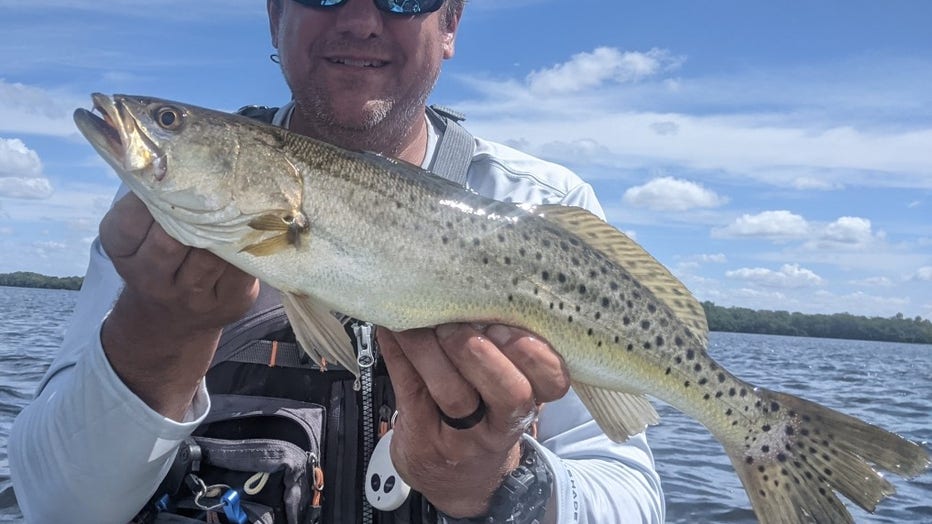
Trout (Credit: Hubbard's Marina)
Redfish action remained steady this past week around the area we are seeing them around the docks, bridges, flats, oyster bars, and mangrove islands. They are feeding well at night around dock lights and bridge lights at the bottom, but the predominate majority of fish are being caught around the flats, islands and oyster bars in the early morning or dusk hours.
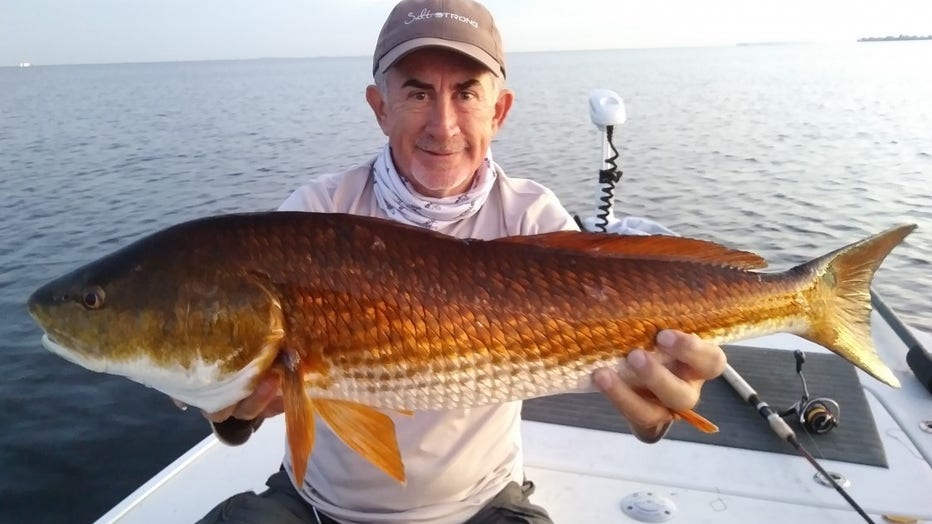
Redfish (Credit: Hubbard's Marina)
Look for schools of mullet around the flats as a great indicator of where those redfish will be feeding best. Often, redfish and others will follow the mullet as they forage the grass because they will spook out the crustaceans and bait fish the redfish are looking to eat. This time of year, they are heavily crustacean-orientated, but they will take white bait, small pinfish and even cut dead bait like ladyfish, threadfins or mullet.
Snook action has been decent lately too, but the trout and redfish seem much more prolific and aggressive overall. We are seeing the snook at night around the docks, bridges, piers and jetties hanging adjacent to the lights, feeding on unsuspecting baits that venture too close to their hiding spots. Look for ambush points where the snook can hang outside the current, but still take passing baits as the current moves them into the strike zone.
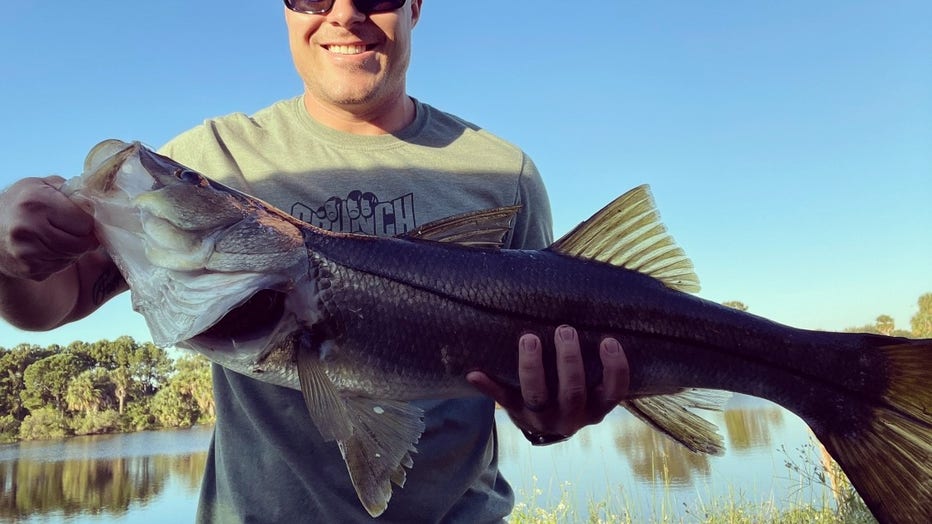
Snook (Credit: Hubbard's Marina)
Remember, if you’re working artificial lures, you have to present your bait naturally to this strike zone. This means you have to work your lure with or across the current not against it. Always cast up tide either directly or just forward of perpendicular to the current to ensure the most natural presentation of your artificial lure.
With live bait, the same holds true but is less important. as long as the bait has time to move past the ambush point with slack in the line to move naturally. Snook are also feeding well during the early morning hours around dock lines, bridges, piers, jetties, and the grass flats. During the day, you can find them in similar areas where they are just less apt to feed unless the tide is just right.
Mangrove snapper action still going well in the area, but we are moving to the backside of the peak time of year for mangrove snapper action. We see them most active and prolific around that summertime warmer weather. When it starts to cool, they start to get less and less concentrated around local docks, piers, bridges, jetties and rock piles like they are most of the summer. However, we always have those mangrove snapper in the area, but they just get less aggressive and concentrated as the waters cool off this time of year.
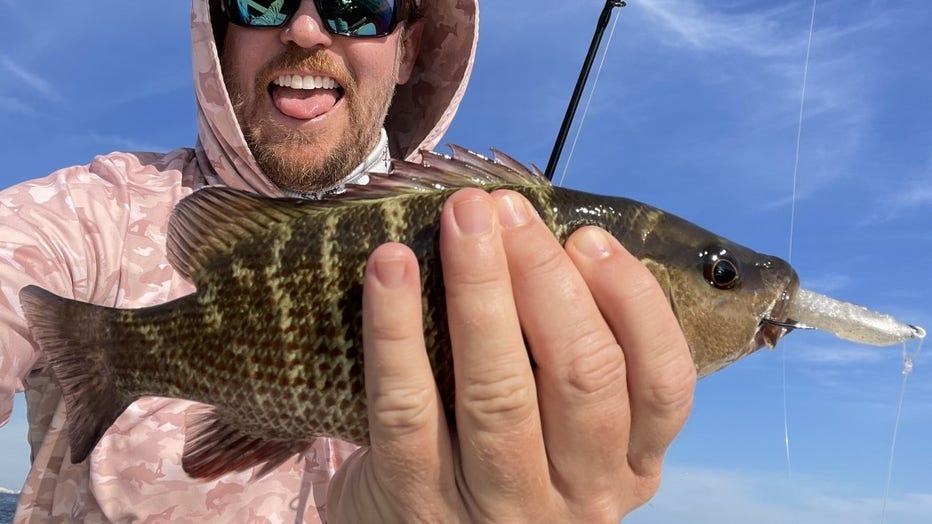
Mangrove snapper (Credit: Hubbard's Marina)
Sheepshead on the other hand, they love when it cools off and get more and more concentrated in the same areas the mangrove snapper hung out all summer. These guys seem to thrive when those cold fronts start to roll through and make the waters more murky and muddy. They love the small pieces of shrimp, cut oysters, clams, barnacles or fiddler crabs. Using light tackle and small hooks around and minimal weight is a great way to target these great eating, but very bony sheepshead.
Black drum are biting well around our backwater areas, especially around the structures like bridges, docks, and adjacent to the flats. We find many of these in big marina areas looking for crustaceans on the bottom. They are a great fight, and the smaller ones are great eating fish. The larger black drum give a great fight but don’t offer as much table fare. Larger live shrimp, crabs, or even cut dead crabs on the bottom around these structures of the back bay is a great way to target the black drum. Even in the mouths of rivers, creeks and bayous, you can find some seriously large black drum and have a great time wrestling a few of them in.
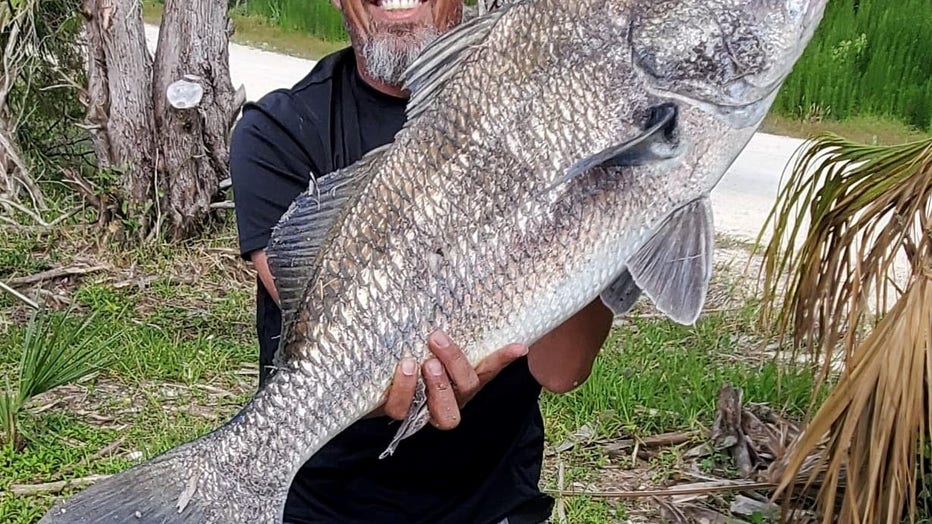
Black drum (Credit: Hubbard's Marina)
Triple tail action remains hot around the area. Look for them while cruising between spots inshore on floating debris, markers and buoys. If you want to target them, often you can catch them even when you don’t see them using minimal weight and a live shrimp fishing the markers of the bay.
With stone crab season starting up, more and more often you will find these traps around with marker buoys and the triple tail love to hide underneath as they cruise in and out of the bay. Along the beaches, large lines of crab traps can be found and they make a great area to cruise and sight fish these unique and great eating fish.
Tarpon action is slowing down overall but many of the smaller juvenile tarpon hangout throughout the year in the back bay waters. Even pushing into brackish areas, many tarpon can be caught if you’re looking in those areas where water is moving and bait is present at the mouths of rivers, creeks, bays and bayous.
Near shore
Lane snapper fishing is off the charts right now and, luckily, we can still harvest them until end of day October 17. You still have more time to get out there near shore and load up on these great eating, super prolific, and fun to catch lane snapper.
Keep in mind, once NOAA finally implements the rule the Gulf Council passed in January this year, the season will reopen and we should not see further or future closures on lane snapper in the years following that rule change and catch level increase.
Lane snapper love the live shrimp, cut pieces of thread fin and even squid on lighter tackle and we often get plenty targeting the hogfish near shore.
Hogfish action is really starting to pick up. However, it’s still pretty spotty day to day but we have had days where we catch double-digit keeper hogfish, even on our 5-hour half-days on the party boats. This past Wednesday, we caught 11 keeper hogfish using live shrimp and lighter tackle.
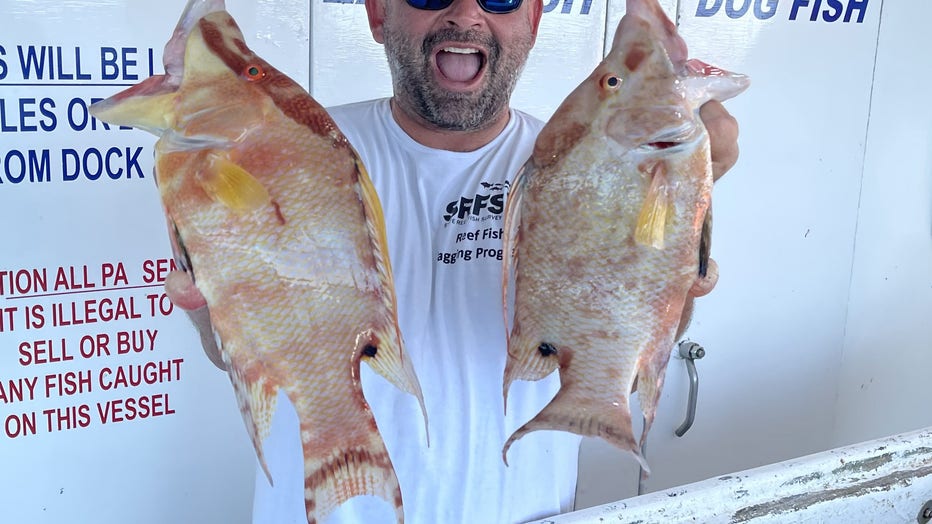
Hogfish (Credit: Hubbard's Marina)
When more experienced anglers come out with us on our 5 and 10-hour trips, we will often have an even better chance at catching higher numbers of keeper hogfish. They are biting best from around 40-60 feet of water, but you can find them deeper and more shallow too. Around 30lb floro leader with about a 3-4ot hook is a great way to target the hogfish. Here’s a great video showing you the rod, reel, leader, and tackle set ups we use to catch plenty of good eating hogfish while fishing near shore. Click the fifth video down on a mobile device or second row middle on a computer.
We are also seeing some mangrove snapper action near shore too, but they are much more leader shy and smart like the hogfish and take a really natural presentation and some patience to dial in on. However, using that double snell rig and a small chunk of cut threadfin is a great way to target these good eating mangrove snapper near shore.
We also catch them from time to time using the hogfish methods laid out in the video at the end of the hogfish report above, but you will catch them more frequently using small chunks of threadfin and a double snell near shore since everything out there will bite a shrimp. The bycatch numbers are much higher when using the live shrimp for bait.
Plus, the shrimp comes off the hook a little more easily compared to a chunk of threadfin on a double snelled hook rig. At the same video link above, you can find a video on how to tie and a video on how to rig that double snell hook set up.
Gag grouper are around near shore, but they are few and far between. While targeting these more prolific snapper and hogfish near shore on lighter tackle, if we do hook into a gag grouper, most of the time you don’t have a real shot at landing one. Plus, the lack of live bait lately has made targeting them even more difficult. However, if you can beat the red tide and get some live pinfish near shore, you have a much better shot at targeting the gags on ledges, rock piles and other hardbottom structures.
Mackerel are thick near shore in areas of clean water where bait is present. We did have huge areas of bait and mackerel nearly on the beaches prior to the recent red tide bloom. Often we catch them while trolling planners and spoons on our way offshore or near shore fishing aboard our party boat fishing trips.
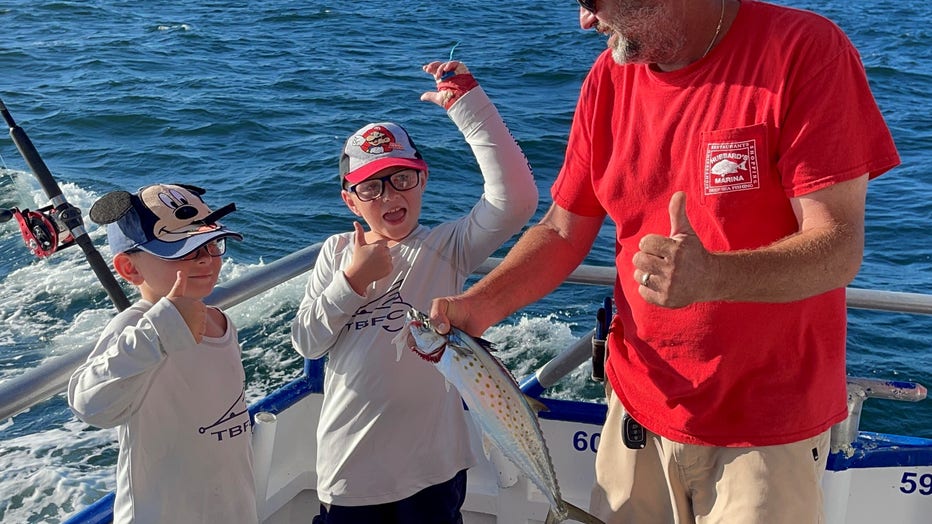
Mackerel (Credit: Hubbard's Marina)
Kingfish are around too, but they are just starting to arrive near shore and water temperatures are not optimal yet. However, we are starting to see them in the near shore waters and especially deeper near shore where red tide isn’t around and the water temperatures are a bit more in their range. The best to see a chance of decent kingfish concentration is around 72-78 degrees, but about 73-75 degrees is optimal.
Offshore
This past week we had the pleasure of filming a fishing show with our friends and Hubbard’s Marina crew aboard the Flying HUB 2. We flew out to around 60-80 miles offshore on Monday this past week and absolutely destroyed it out there with snapper, grouper, scamp, and more!
The mangrove snapper bite was on fire all day long at the start of this past week, around 160-200 feet of water. We saw this aboard the flying HUB 2 trip but also our 39-hour private charter that fished Sunday to Tuesday brought back a huge pile of mangrove snapper saying they saw the same daytime hot mangrove snapper action.
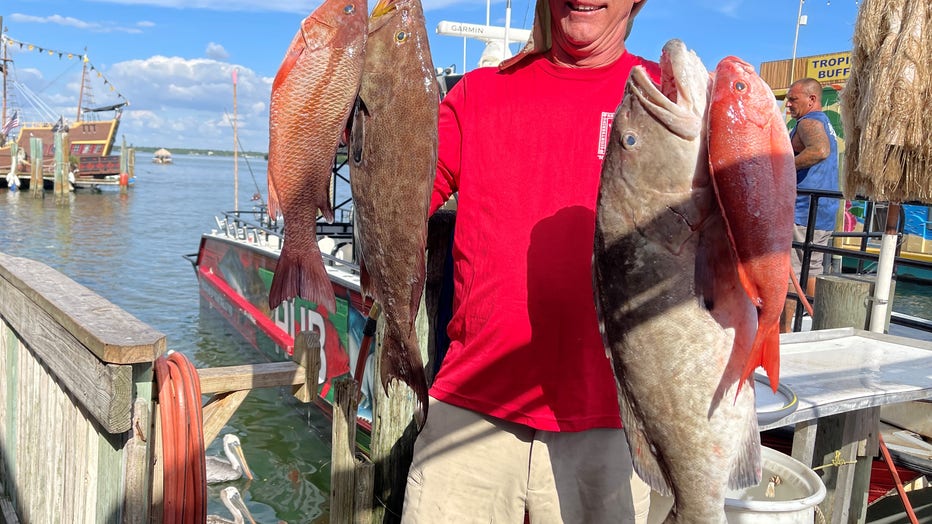
Mangrove snapper, scamp grouper, gag grouper and vermillion snapper (Credit: Hubbard's Marina)
This is likely has to do with fishing a few days prior to the new moon plus, we had the moon rise nearly in conjunction with the sunrise and when the moon is up all day with the sun, often the daytime action is much better too as they fish cannot feed at night without the light of the moon. The double snell rig with cut threadfin was the bait of choice to target plentiful mangrove snapper.
While dialed into the mangrove snapper, using only threadfin for bait, we also saw huge red grouper, red snapper and triggerfish which all had to be caught and released. Luckily, that was the case or we would have been out of ice and cooler space after our first two stops.
Not only were mangrove snapper chewing well, but also big porgies, vermillion, almacos, scamp grouper and the occasional gag grouper too. We had multiple scamp grouper in the 10-15lb range, and I had one that must push closer to 16 pounds - one of the largest scamp grouper I have seen to date.
My father ended up catching the largest gag grouper of the day and it was a great testament to old school vs. new school mentality. I am more apt to use a two-speed reel with double snell and around 60-80bl test with double snell 6-7ot hooks while fishing deep water offshore. While my father is solid 80-100lb and single 7ot hook and is happy to sit and soak a big bait for 20-40 minutes while I slap mangrove snapper after mangrove snapper on the deck at his feet. He simply smiles and waits.
Then BOOM, he gets slammed by a big gag grouper on a butterflied porgy and ends up with the big fish of the day. Granted, he caught less numbers, but he did get the biggest fish. However, I was happy to limit out on mangrove snapper and catch three keeper scamp with one monster scamp along with countless vermillions, multiple throwback red snapper and one red grouper that I could have mounted. It was so large, but his one 20+ pound gag grouper and multiple big mangrove snappers were looking mighty comparable back at the dock.
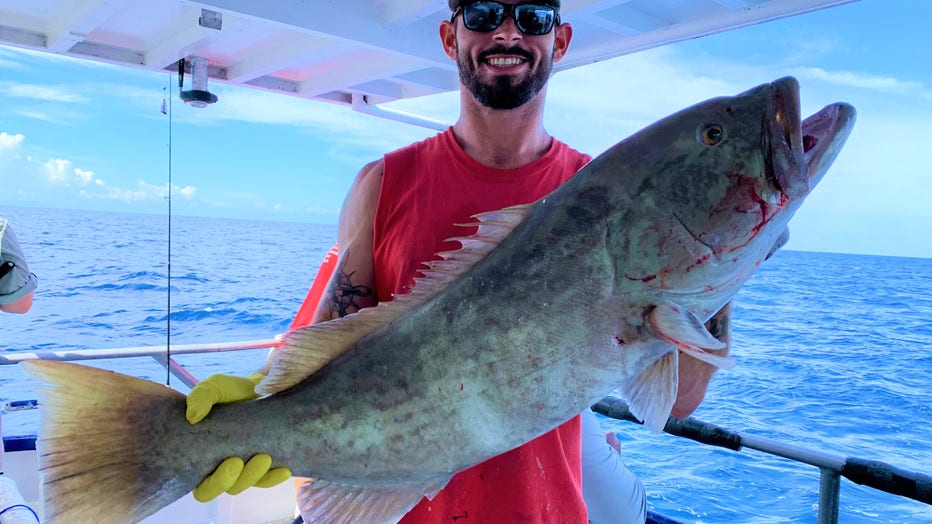
Gag grouper (Credit: Hubbard's Marina)
You decide how you want to fish and settle on what you’re comfortable doing. You want to soak big baits with big patience for an opportunity at a trophy fish? You still must successfully get off the bottom before he breaks you off. Or, do you want to use a little lighter tackle and smaller baits and be more productive with a much more diminished chance at a trophy fish?
We talked about this in the last live show this past Sunday night and it was just so comical. The very next day I saw it play out again during a fishing trip and my father just grins and gives me the look like, ‘Mine was bigger so.’
Nothing beats fishing with your dad, and nothing is more memorable. Hopefully you enjoyed the more fishing story in this report compared to the typical setup! Just wait until you see the final video on our YouTube channel.
DON’T BE A FOOL, bring a venting tool & descending device
Keep in mind the importance of dead discards and discard mortality when engaged in near shore or offshore fishing. How many do you know right now that are all for catching and releasing snook, redfish, and trout but will be the first in line to kill a mangrove snapper, gag grouper, or red snapper? But the attitude completely changes when discussing these offshore species?
Plus, the same person inshore that will hold their breath and wet their hands before handling a breeder snook will go offshore and then cull through 20 red snapper before keeping their two red snapper they deem large enough to fill their two-fish bag limits. Meanwhile, the other 18 they released will often end up suffering fatal damage if not properly descended or vented?
Please help us to spread the word on the importance of descending or venting your released fish. Descending devices are most easy to use and quick to pick up on their use. They are most effective for most anglers.
However, an expert and precise angler with proper training and tons of experience can use a venting tool properly with similar outcomes. A venting tool requires you to pierce the fish while most descending devices are much less invasive. While using a venting tool, it is imperative you pierce them in the exact right spot, and you do not go but a quarter-inch or less in the fish. Most venting tools require you to ‘choke up’ on the tool to prevent over-penetration into major organs.
When fishing deep water, especially in the hot summer months, please make sure to treat all fish intended to be released like that breeder snook inshore and minimize the time it takes you to get him from the bottom to the boat using heavier proper tackle, not an ultra-light spinning reel.
Then once onboard, minimize the time out of the water. Then use a proper de-hooking tool and then, for the love of God, use a descending device or venting tool PROPERLY to ensure that fish has a chance to live another day.
Three things will help ensure the survivability of those fish released offshore:
- Making sure they are brought up quickly and do not expend all their energy in the fight.
- Make sure they are unhooked smoothly, easily, and as quickly as possible.
- Finally, make sure they spend the least amount of time at the surface at negative pressures where barotrauma exponentially increases its effect with each passing second.
Also, keep in mind when the water is warm, there is less dissolved oxygen content and the chances of barotrauma increase even more while its effects can be even more deadly.
LINK: Here’s all the information and more on barotrauma and how to mitigate that fatal damage to your future offshore catch
**Note: I recommend the Salt Strong articles at the bottom of the page under ‘webpages.’ I helped them develop those personally.
STATE SURVEY to improve recreational data and access
It is imperative that you have your Gulf Reef Fish survey endorsement on your fishing license.
You should get one if you are a private recreational angler or diver fishing from a private boat anywhere in Florida who intends to harvest, attempt to harvest or possess one or more of the following reef fish species: mutton snapper, yellowtail snapper, hogfish, red snapper, vermilion snapper, gag grouper, red grouper, black grouper, greater amberjack, lesser amberjack, banded rudderfish, almaco jack, gray triggerfish, Gag grouper, Red grouper, Scamp grouper, Mangrove snapper, Lane snapper, Kingfish, Tuna, or Mahi mahi.
Here is all the information and more on that program and how you can sign up.
TERMS OF REFERENCE:
INSHORE – from the back bays out to the bridges and including right on the beaches
NEAR SHORE – From the beaches out to 20 miles, or up to 100ft of water
OFFSHORE – from 20 miles or 100ft and beyond
For more fishing reports, photos, videos and more check out Hubbard’s Marina on Facebook, Instagram, YouTube, or Snapchat. Just simply search "HubbardsMarina" and do not forget our family motto, "If you’re too busy to go fishing, you’re just too busy!

